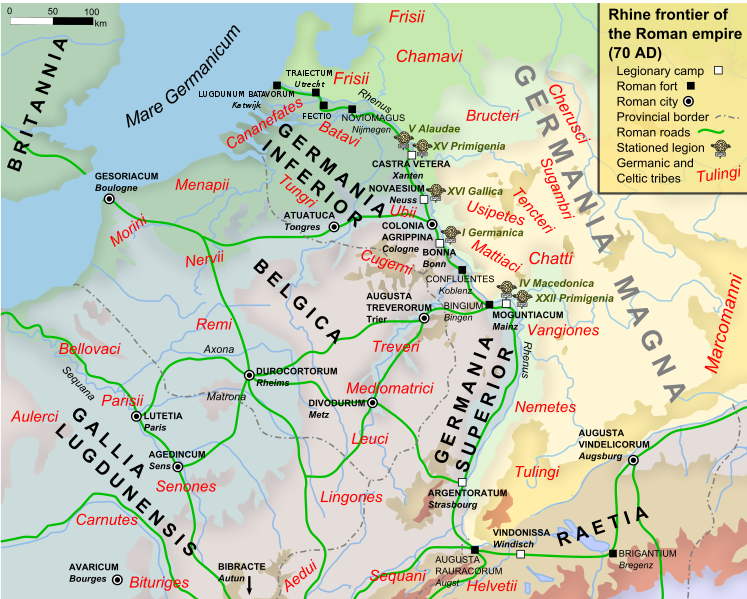


Notice: This is the official website of the All Empires History Community (Reg. 10 Feb 2002)
Kurds are German? |
Post Reply 
|
Page <1 45678 20> |
| Author | ||
Xorto 
Shogun 
Joined: 06-May-2010 Location: Germany Online Status: Offline Posts: 224 |
 Quote Quote  Reply Reply
 Topic: Kurds are German? Topic: Kurds are German?Posted: 09-May-2010 at 10:14 |
|
|
I don´t know where you get this statistic but sorry thatsrealy wrong what you are trying to explain us. Look at this map. This is the map of I2a http://www.eupedia.com/images/content/Haplogroup_I2a.gif The highest rate is between the regions Diyarbakir Adiyaman, Mardin, Sirnak Bitlis Elazi, Dersim, Van and so on. how could the rate of I2a could be higher among zaza kurds than by kurmancis. When the population of kurmanci speaking people is by 13 Mio and Zazaki 3-4. You can´t split the rate between this to groups because they are hardly mixed. The only thing i know is that the R1a and J2 Rate is higher among kurds from Iran and Irak than Syrian and turkey kurds. But in fact when youput them all together i would say. Amon Kurds. R1a-b is by 45-55% I by 20% J2 by 20-25% and G 12-15% |
||
 |
||
Ince 
Colonel 
Joined: 24-Dec-2009 Online Status: Offline Posts: 550 |
 Quote Quote  Reply Reply
 Posted: 09-May-2010 at 15:53 Posted: 09-May-2010 at 15:53 |
|
A few months ago I did alot of search on Genetics and Kurds and I rememberd them from my readings. I know that the one from http://www.eupedia.com/europe/european_y-dna_haplogroups.shtml here uses Kurmanji and Zaza average combined as it was similar to article I had read. For example heres somthing from wikipedia regarding the P/R2, http://en.wikipedia.org/wiki/Haplogroup_R2_%28Y-DNA%29#Caucasus "One study has found Haplogroup R2 at an unusually high frequency of 44% (11/25) among Kurmanji speakers (Kurmanjs) in Georgia, but at a much lower frequency of 8% (7/87) among Kurmanjs in Turkey.[8]" |
||
 |
||
Xorto 
Shogun 
Joined: 06-May-2010 Location: Germany Online Status: Offline Posts: 224 |
 Quote Quote  Reply Reply
 Posted: 09-May-2010 at 17:49 Posted: 09-May-2010 at 17:49 |
|
|
@Ince the kurdish Population in georgia is not higher than 2-4 thousand. don´t you thing that a part this kurmanci speakers could be in fact kurdish sintis or romas?
|
||
 |
||
Ince 
Colonel 
Joined: 24-Dec-2009 Online Status: Offline Posts: 550 |
 Quote Quote  Reply Reply
 Posted: 09-May-2010 at 17:55 Posted: 09-May-2010 at 17:55 |
|
It could be, because the Mittani are believed to have been Sindhi and they could of been Mittani tribes. According to the Kurd Mehrdad Izady, the Mittani were Sindhi in origin. |
||
 |
||
Xorto 
Shogun 
Joined: 06-May-2010 Location: Germany Online Status: Offline Posts: 224 |
 Quote Quote  Reply Reply
 Posted: 09-May-2010 at 18:07 Posted: 09-May-2010 at 18:07 |
|
|
I had my Suspicion thats why i thought so. when you look h8% of Kurds in Anatolia have R2. And i estimate the % population of Sintis in hole Kurdistan by 2% so it comes near to it.
|
||
 |
||
Shield-of-Dardania 
Consul 

Suspended Joined: 23-Mar-2010 Online Status: Offline Posts: 357 |
 Quote Quote  Reply Reply
 Posted: 09-May-2010 at 18:26 Posted: 09-May-2010 at 18:26 |
|
|
Sindh, as a western frontier of the Indian subcontinent, has always been exposed to the entry of migrants from Central Asia and the Middle East. The invasion/immigration of the Aryans around 1500 BC altered the demographic composition of Sindh forever.
The Dravidians were the original inhabitants of Sindh and founded the prosperous Indus Valley Civilisations, which included the cites of Mohenjo-Daro and Harappa. However, the arrival of the Aryans pushed Dravidian populations southward into the Deccan plateau. The people known as Sindhis today, like most of the inhabitants of the entire South Asia, are mainly the product of Aryan-Dravidian interbreeding.
Sindh has continued to experience immigration from Central Asia and the Middle East since the arrival of the Aryans. Iranians, Turks and other Central Asian ethnic groups migrated in large numbers to further mix up the curry-masala of Sindhi ethnic composition.
extracted n adapted from: http://en.wikipedia.org/wiki/Sindhi_people Edited by Shield-of-Dardania - 09-May-2010 at 18:47 |
||
|
History makes everything. Everything is history in the making.
|
||
 |
||
Ince 
Colonel 
Joined: 24-Dec-2009 Online Status: Offline Posts: 550 |
 Quote Quote  Reply Reply
 Posted: 09-May-2010 at 18:40 Posted: 09-May-2010 at 18:40 |
|
Also found this, and thought I'd post it.
|
||
 |
||
Ince 
Colonel 
Joined: 24-Dec-2009 Online Status: Offline Posts: 550 |
 Quote Quote  Reply Reply
 Posted: 09-May-2010 at 19:35 Posted: 09-May-2010 at 19:35 |
|
Because when they did those tests, they tested same amount of people from each group. So it is the average based on those 2 groups that they tested. They did not test high amount of Kurds in Turkey, nor did they go to every city in Turkey to get a better picture. J2 will be higher among Kurds, as J2 is the most common Haplogroup in the Mesopotamia. Also J2 is also very high in North Iran among the Azari. I still don't know which group brought in the Haplogroup I. The Zaza do have high amount of I,higher then the Kurmanji, but that is based on the tests on the groups they tested. Also according to this, they show that the Zaza have higher I, all testing will have different outcomes. thats why some sites have different results. Look at page 8. http://docs.google.com/viewer?a=v&q=cache:JlcJWkgdEF8J:www.eva.mpg.de/genetics/pdf/Kurds.pdf+dna+kurds+origin&hl=en&gl=uk&pid=bl&srcid=ADGEESijyvy3sciGUFkOhMJ349LwIYYYTR-hpZn42bcFH6NGNnHe-qmbwenGARcMP0w6L4UExyyfdzKNwyAd0qyPjgwh5TR6bwMulQjdHIpoAzNiDihP2QfEpLuV1eISyUC6qGOgnNBz&sig=AHIEtbSAXuwXf99Ekej7_12dBk1lckiMYw Edited by Ince - 09-May-2010 at 19:42 |
||
 |
||
Maximus Germanicus 
Pretorian 
Suspended Joined: 08-May-2010 Online Status: Offline Posts: 171 |
 Quote Quote  Reply Reply
 Posted: 09-May-2010 at 21:17 Posted: 09-May-2010 at 21:17 |
|
First-- There was a very significant celtic impact to German culture. esp south of the Ruhr-Rhine area. In the Northern area, esp along the Rhine left and right bank the Frank confederation as well as the saxon federation were ruthless in wiping out local populations during the migrations. However south of that area it seems if the celtic tribes pledged thier loyality to the germanic tribes they were merged into the tribes. The cletic language disapperad and they took on Germnic customs and language.
What strikes me as funny is the similitaries of celtic and germanic mythology.
Odin of course (wodan in west germanic) stikes a huge similartity to Lugus of the contiental celts. the magic spear, the rainbow, the ravens--Odin had one eye, Lugus closed one eye during combat. I wonder if the Norse and Germanic religions originated from the celtic.
I copied this from an online source
"It is also worth noting that parallels exist between the Irish Lugh, Gaulish Lugus, Germanic Wotan and Norse Odin. Odin was worshipped by the Norse as a god of war among other things including poetry and the arts. Odin appears to have replaced Tyr as god of war among north Germanic peoples. As such, it may be that Lugh was also worshipped as a god of war by the Irish. On that note it is worth noting that the ultimate Irish warrior hero Cu Chulainn is cited as the son of Lugh." end quote
So maybe the celts taking on German tradtions or vica versa wasn't that hard for the tribes to join together.
The Swiss are a mixture of germanic and germanized celts and some alos wonder if the Bavarians were also.
The romans named ribes german or celtic by where they lived- the romans didn't really make a huge racial differnce. If they lived in G-I, G-S or G-M they were German otherwise they were Gauls (celts)
The Trevini were in the area of L-burg and Belgium--prob releated to the Belgic-- Their former territory was over run by the Franks-- The Franks were pretty ruthless in that area and absorbed the tribe by force our wiped them out.
Thevini were only on both sides of the Rhine becuase the Romans gave them authority over the area, when the provinces of G-I and G-S were est the Tre-- were returned to there traditional areas in Luxembourg
|
||
 |
||
Maximus Germanicus 
Pretorian 
Suspended Joined: 08-May-2010 Online Status: Offline Posts: 171 |
 Quote Quote  Reply Reply
 Posted: 09-May-2010 at 21:24 Posted: 09-May-2010 at 21:24 |
|
|
On Bismark--
The Prussinas were on odd group. The court spoke French thats why the Blue Max the highest honor and the Prussian military was in French.
They def were mixed with the Slavic tribes esp in ost Prussia. Bismark did a lot to harm Germany. Germany was a ploygot of tribes and dialects, the Prussians forced a unifaction of both religion and language. Portesantism was forced in a lot of areas causing a migration to the US esp from the Rheinish Prussia and WF. Bavaria was powerfull enough to avoid the kulturekampf and retained thier id- Cologne also was powerfull enough while in prussia that area remained forcefully catholic.
|
||
 |
||
Shield-of-Dardania 
Consul 

Suspended Joined: 23-Mar-2010 Online Status: Offline Posts: 357 |
 Quote Quote  Reply Reply
 Posted: 09-May-2010 at 23:29 Posted: 09-May-2010 at 23:29 |
|
|
What about the Austrians? How n where do they fit in, in the wider Germanic realm? |
||
|
History makes everything. Everything is history in the making.
|
||
 |
||
Xorto 
Shogun 
Joined: 06-May-2010 Location: Germany Online Status: Offline Posts: 224 |
 Quote Quote  Reply Reply
 Posted: 10-May-2010 at 05:56 Posted: 10-May-2010 at 05:56 |
|
|
@Ince yes you are right but i think you didn´t understood what i wanted to say. Look the total population of kurds in anatolia is by like 18 mio. 4 Mio of them are Zaza and 14 Mio kurmanci speaker. 19-20% of kurmanci speakers have I that means like 3 Mio kurmanci speakers are I while 30% of zazaki speakers have I that means like 1.333.... Mio of Zaza have I per centrual maybe the HG I is higher among zaza speakers. But in population by kurmanci speakers. The reason why you have more other influences among kurmanci speakers is that Kurmanci is like the main kurdish dialekt in Anatolia and that every group which came to northkurdistan first learns to speak kurmanci. What i want to say is for sure kurmanci has assimilated more not kurdish populations than zazaki speakers. Just look at Mardin like 10% of the kurmanci speakers there are of Aramaic origin. Fact is among NorthKurds(not matter zazaki or kurmanci) the highest Haplogroups are I R1a-b J2
|
||
 |
||
Ince 
Colonel 
Joined: 24-Dec-2009 Online Status: Offline Posts: 550 |
 Quote Quote  Reply Reply
 Posted: 10-May-2010 at 16:26 Posted: 10-May-2010 at 16:26 |
|
Ok now I get what you mean. Yes many people were assimilated into the Kurmanji population. Like Armenians that were escaping Turks. Plus the Native population of Anatolia that were Kurdified. Haplogroup K could of been the marker of maybe Aborgines that used to live in Anatolia. Plus not all Kurds look the same from Anatolia, the Kurds that live closer to the Syrian border and South Anatolia tend to look darker, like in Urfa, where their is also Arab population living their. Also heres Y-DNA for Iran. 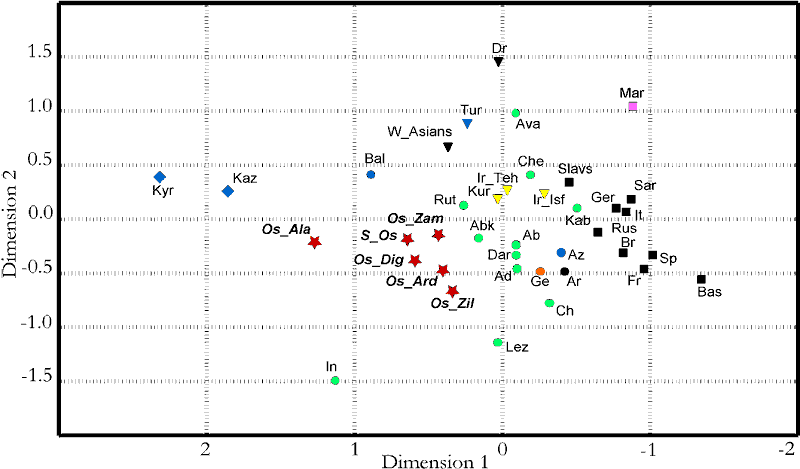 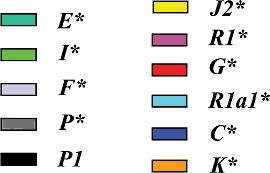 Iranians from Tehran 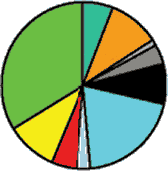 Iranians from Isfahan 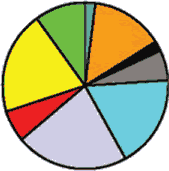 Edited by Ince - 10-May-2010 at 16:30 |
||
 |
||
Ince 
Colonel 
Joined: 24-Dec-2009 Online Status: Offline Posts: 550 |
 Quote Quote  Reply Reply
 Posted: 10-May-2010 at 16:29 Posted: 10-May-2010 at 16:29 |
|
|
Their is a high amount of K and F among the Iranian people, more frequent further south, could of been from the Elamites?
Edited by Ince - 10-May-2010 at 16:31 |
||
 |
||
kalhur 
Earl 
Joined: 23-Jan-2010 Online Status: Offline Posts: 263 |
 Quote Quote  Reply Reply
 Posted: 10-May-2010 at 16:43 Posted: 10-May-2010 at 16:43 |
|
|
WHO WERE THE NEANDERTHALS?  A different form of human to us; lived in Europe, the Middle East and Central Asia Genomic data shows Neanderthals diverged from our evolutionary line 400,000 years ago The last known Neanderthals died out in the Iberian Peninsula roughly 24,000 years ago Stocky and muscular, with a barrel chest, large brain and prominent facial features. Neanderthals were first recognised from fossils found in north-west Germany in 1856 DNA studies show they were probably capable of speech and some even had red hair. i am really sorry i find that i am probably a mix-breed nean+ sapiens. i am very stocky and hairy and my late father had red hair  and a kurdish aborigin too -because i have Y hg K2=T m70 and a kurdish aborigin too -because i have Y hg K2=T m70  Edited by kalhur - 18-May-2010 at 01:20 |
||
 |
||
Ince 
Colonel 
Joined: 24-Dec-2009 Online Status: Offline Posts: 550 |
 Quote Quote  Reply Reply
 Posted: 10-May-2010 at 17:01 Posted: 10-May-2010 at 17:01 |
|
|
I don't think Neanderthals would of been able to have mated with Homo-Sapiens, plus no genetic evidence has been found to suggest that they were assimilated into modern humans.
Heres a map of world frequencey of Haplogroup T. http://upload.wikimedia.org/wikipedia/commons/4/40/Distribution_Haplogroup_T_Y-DNA_II.svg |
||
 |
||
kalhur 
Earl 
Joined: 23-Jan-2010 Online Status: Offline Posts: 263 |
 Quote Quote  Reply Reply
 Posted: 10-May-2010 at 17:12 Posted: 10-May-2010 at 17:12 |
|
|
Neanderthal DNA may be commonplace in human genomes outside Africa as a result of interbreeding around 60,000 years ago. Photograph: AFP/Getty Images There is a little Neanderthal in nearly all of us, according to scientists who compared the genetic makeup of humans with that of our closest ancient relatives. Most people living outside Africa can trace up to 4% of their DNA to a Neanderthal origin, a consequence of interbreeding between the two groups after the great migration from the contintent. Anthropologists have long speculated that early humans may have mated with Neanderthals, but the latest study provides the strongest evidence so far, suggesting that such encounters took place around 60,000 years ago in the Fertile Crescent region of the Middle East. Small, pioneering groups of modern humans began to leave Africa 80,000 years ago and reached land occupied by the Neanderthals as they spread into Eurasia. The two may have lived alongside each other in small groups until the Neanderthals died out 30,000 years ago. Scientists led by Svante Pääbo at the Max Planck Institute for Evolutionary Anthropology in Leipzig took four years to sequence the whole Neanderthal genome from powdered bone fragments taken from three females who lived in Europe 40,000 years ago. To see how similar the Neanderthal was to modern humans, the team compared the ancient DNA with the genomes of five people from France, China, southern Africa, western Africa and Papua New Guinea. The study is the first to attempt a whole-genome comparison between Neanderthals and modern humans. The researchers found that modern humans and Neanderthals shared 99.7% of their DNA, which was inherited from a common ancestor 400,000 years ago. Further analysis revealed that Neanderthals were more closely related to modern humans who left Africa than to the descendants of those who stayed. Between 1% and 4% of the DNA in modern Europeans, Asians and those as far afield as Papua New Guinea, was inherited from Neanderthals. "Those of us who live outside Africa carry a little Neanderthal in us," said Professor Pääbo. "Neanderthals probably mixed with early modern humans before Homo sapiens split into different groups in Europe and Asia. The comparison of these two genetic sequences enables us to find out where our genome differs from that of our closest relative." Interbreeding between humans and Neanderthals may nonetheless have been rare. Just two Neanderthal females in a group of around a hundred humans would have been enough to leave such a trace in our genome, provided that was the group that gave rise to all modern humans outside Africa. The study, reported in the journal Science, was greeted by scientists as almost certain confirmation that modern humans and Neanderthals mated when the groups crossed paths. "It certainly tells us something about human nature," said Chris Stringer, head of human origins at the Natural History Museum in London. Ed Green, a senior author on the study at the University of California, Santa Cruz, said: "How these peoples would have interacted culturally is not something we can speculate on in any meaningful way. But knowing that there was gene flow is important, and it is fascinating to think about how that may have happened." He added: "The scenario is not what most people had envisioned. We found the genetic signal of Neanderthals in all the non-African genomes, meaning that the admixture occurred early on, probably in the Middle East, and is shared with all descendants of the early humans who migrated out of Africa." The German group has yet to investigate what purpose, if any, the Neanderthal genes play in modern humans. But the study did highlight several genes that are unique to modern humans. They are thought to be involved in the development of brain function, features of the skull, metabolism and formation of the collar bone and rib cage. "A major next step will be to find out not only what the unique human genes are doing, but whether the genes we've got from Neanderthals are of functional significance. Is there something in the biology of people outside Africa that is coming from those Neanderthal genes?" said Prof Stringer. YOU SEE I AM BOTH KURDISH ABORIGIN AND MIX -BREED NEANDETHAL TOO EVEN MY EX- GIRL FRIEND FROM AFRICA TOLD ME: YOU ARE REALLY A BEAST Edited by kalhur - 10-May-2010 at 17:19 |
||
 |
||
Xorto 
Shogun 
Joined: 06-May-2010 Location: Germany Online Status: Offline Posts: 224 |
 Quote Quote  Reply Reply
 Posted: 10-May-2010 at 17:15 Posted: 10-May-2010 at 17:15 |
|
 no man you don´t look near like a neanderthaler you seem more european as middle eastern even to me. no man you don´t look near like a neanderthaler you seem more european as middle eastern even to me.
|
||
 |
||
Xorto 
Shogun 
Joined: 06-May-2010 Location: Germany Online Status: Offline Posts: 224 |
 Quote Quote  Reply Reply
 Posted: 10-May-2010 at 17:16 Posted: 10-May-2010 at 17:16 |
|
|
haplogroup k is also common among europeans and nortafricans. F also.
|
||
 |
||
Ince 
Colonel 
Joined: 24-Dec-2009 Online Status: Offline Posts: 550 |
 Quote Quote  Reply Reply
 Posted: 10-May-2010 at 17:19 Posted: 10-May-2010 at 17:19 |
|
|
Thats new to me. I was watching a program about the Neaderthals and the program was saying it was unlikely they had mated. The program could of been old and this new information says we did mate with them. Everyone who had left Africa thousands of years ago, has a little Neanderthal

|
||
 |
||
Post Reply 
|
Page <1 45678 20> |
| Forum Jump | Forum Permissions  You cannot post new topics in this forum You cannot reply to topics in this forum You cannot delete your posts in this forum You cannot edit your posts in this forum You cannot create polls in this forum You cannot vote in polls in this forum |
Copyright ©2001-2009 Web Wiz
This page was generated in 0.096 seconds.











 Printable Version
Printable Version Google
Google Delicious
Delicious Digg
Digg StumbleUpon
StumbleUpon Windows Live
Windows Live Yahoo Bookmarks
Yahoo Bookmarks reddit
reddit Facebook
Facebook MySpace
MySpace Newsvine
Newsvine Furl
Furl Topic Options
Topic Options